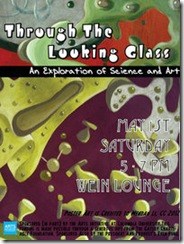|
The Columbia Science Review, Scientists and Engineers for a Better Society and the Center for the Study of Science and Religion have joined forces to organize Through the Looking Glass – a science art exhibit aimed at exploring these two seemingly disparate fields. We aim to break down boundaries and create conversation between artists, scientists and viewers.
With generous funding from CU Arts and the President’s and Provost’s Fund, we have brought together a diverse group of media and topics by Columbia students and affiliates. Each one explores scientific imagery and concepts in an attempt to bridge the gap between what we conventionally think of as two separate worlds. Come and enjoy the multimedia artwork and learn about something new. Saturday May 1st @ Wien Lounge 5PM-7PM. FREE hors d’oeuvres will be served. Please RSVP on our Facebook Event.
0 Comments
Yet more of the oven fresh goodness straight from the lab as posted on our twitter account @spread_science
Last Saturday, all the buzz centered around Apple’s newest product, the revolutionary Ipad. Techies swarmed to the nearest Apple store to test out the liquid crystal display touchscreen and the three-axis accelerometer. So what is the technology behind the innovation? The screen is made of oleophobic scratch-resistant glass and does not need a stylus to control. The lithium-ion polymer battery can withstand 10 hours of continuous video or 140 hours of music. This piece of art has internal memory of up to 64 GB, more than triple the capacity of an IPod. With such an array of functions, the iPad does not come cheap- half a grand is need to possess this neat gadget. Price aside, my classmates and friends still joke that the IPad is merely the super-sized version of the IPod Touch. Do you think the technological and practical uses of the IPad outweigh the price tag?
~HW Here is a list of today’s articles that we found interesting, as posted on our twitter account @spread_science:
As a violist and science major, I am super-excited when music and technology collide. Recently, engineering researchers at the University of Jaen in Jaen, Spain have invented a system that can create sheet music based on perception of individual notes. Plus, the individual musician, instrument, or location of performance DOES NOT MATTER.
The system works by identifying the spectral pattern of specific notes (vibrational motions from an instrument) to create a dictionary of sounds. The sound bytes (WAV format) are converted to a reader-friendly version (MIDI format). What is so fascinating about this recent development is the self-learning capacity of this system. So far, it can interpret one instrument’s input at a time, but hopefully it can soon transcribe a whole orchestra’s performance of Vivaldi’s The Four Seasons. –GTB Love fine dining? Researcher Peter Barham, among others, currently propels the effort to further explore a new movement in science called molecular gastronomy. They focus on producing “novel textures and flavor combinations” that are not ordinarily found in the kitchen and emphasize individual diners’ approaches to flavor and “state[s] of mind” when sitting down to a good meal. The molecular gastronomy movement was started not too long ago by Hervé This, with a Ph.D. degree in Physical Chemistry of Materials, and Nicholas Kurti, once a Professor of Physics at Oxford, in 1988, and has since become an international phenomenon. Some of the most recent advances in molecular gastronomy include sodium alginate and calcium-based fake caviar and the Baumé, a coagulated egg dish made from immersing a whole egg in alcohol (ethanol).
–GTB Here’s a quick recipe to get you started on your molecular gastronomy journey (from Wylie Dufresne): PIZZA PEBBLES Ingredients: 105 grams toast powder • 30 grams tomato powder • 45 grams parmesan powder • 45 grams buttermilk powder • 67.5 grams garlic confit oil Procedure: Mix the toast, tomato, parmesan and buttermilk powder together in a bowl. Drizzle in the garlic confit oil (see recipe below). Mix well until it resembles wet sand. Form into small spheres about the size of a dime in diameter and reserve. When rolling is complete, place in sauté pan over medium heat and swirl pan continuously until spheres begin to form smooth “pebbles”. Pour onto a tray, let cool and serve. |
Categories
All
Archives
April 2024
|

